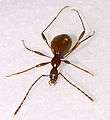Glacicavicola bathysciodes
| Glacicavicola bathysciodes | |
|---|---|
 | |
| Scientific classification | |
| Kingdom: | Animalia |
| Phylum: | Arthropoda |
| Class: | Insecta |
| Order: | Coleoptera |
| Family: | Leiodidae |
| Genus: | Glacicavicola |
| Species: | G. bathysciodes |
| Binomial name | |
| Glacicavicola bathysciodes Westcott, 1968 | |
Glacicavicola bathysciodes also known as the Western Blind Cave Beetle is a species of beetle in family Leiodidae. It is endemic to caves in the western United States.
Description
Glacicavicola bathysciodes is a shiny, translucent, brownish-orange, ant-like beetle, approximately 6 cm long by 2mm wide. It has become well-adapted to the troglobitic lifestyle: It has long thin antennae covered in fine setae, and slender legs (also covered in setae) which allow it to easily traverse the difficult terrain present in its environment.[1] A particularly interesting feature of Glacicavicola bathysciodes is the absence of eyes, and the beetle is completely blind, even lacking optic neuropiles.[2] Their abdomen exhibits false physogastry, which means that their abdomen appears larger than it truly is, due to the enlarged dome-like elytra which covers the entire abdomen.
Biology
Little is known about the biology Glacicavicola bathysciodes (the Western Blind Cave Beetle), due to its unique lifecycle and location. The beetles have been observed to feed on arthropod remains, as well as fungus, and it is speculated that they may eat bacteria as well. No larval form of the beetle has been observed. The beetles are suspected to have a lifecycle of around three years.[1][3]
Range
The Western Blind Cave Beetle originally was discovered by Richard Wescott in Idaho lava tube ice caves along the eastern Snake River Plain of Idaho.[4] It has since been discovered in similar localities, including a limestone cave in Wyoming.[3] The beetles have been associated with humid, cold cave temperatures and ice, and they die when exposed to higher temperatures, which limits their distribution.[5]
 Dorsal Aspect
Dorsal Aspect Ventral Aspect
Ventral Aspect Left View
Left View Note the lack of eyes
Note the lack of eyes
References
- 1 2 Brent Naseath (December 1974). "Investigations of food chains in the blind beetle-cave ecosystems of Idaho". Journal of the Idaho Academy of Science. Idaho Academy of Science: 10,2:77–81.
- ↑ Joseph R. Larsen; Gary Booth; Robert Perks; Ross Gundersen (July 1979). "Optic neuropiles absent in cave beetle Glacicavicola bathysciodes (coleoptera:leiodidae)". Transactions of the American Microscopical Society. Wiley on behalf of American Microscopical Society: 98,3:461–464.
- 1 2 Stewart B. Peck (January 1974). "Biology of the Idaho lava tube beetle, Glacicavicola". The National Speleological Society Bulletin. The National Speleological Society: 36,1:1–2.
- ↑ Richard L. Wescott (June 1968). "A new subfamily of blind beetle from Idaho ice caves with notes on its bionomics and evolution (coleoptera: leiodidae)". Contributions in Science. Los Angeles County Museum of Natural History: 141:1–14.
- ↑ Stewart B. Peck (December 1981). "The Idaho cave beetle Glacicavicola also occurs in Wyoming". The Coleopterists Bulletin. The Coleopterists Society: 35,4:451–452.
Sources
- World Conservation Monitoring Centre 1996. Glacicavicola bathysciodes. 2006 IUCN Red List of Threatened Species. Downloaded on 9 August 2007.
